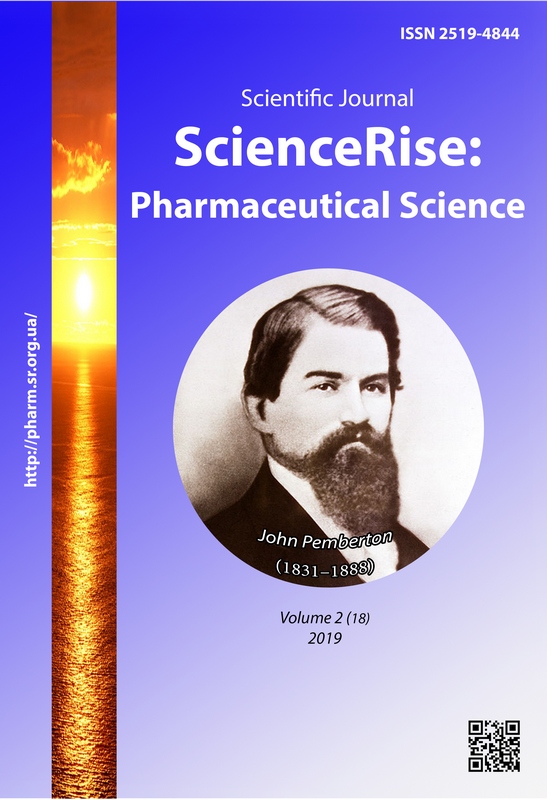Β-lactam antibiotics in Ukraine: market and consumption analysis in 2013–2018
DOI:
https://doi.org/10.15587/2519-4852.2019.165682Keywords:
pharmaceutical market, β-lactam antibiotics, consumption of medicines, ATC/DDD methodologyAbstract
The strategy of combating the development of antibiotic resistance is a global challenge for the scientific community for the sake of life and health of the population. An analysis of the relationship between the levels of antimicrobial drug consumption and the development of antibiotic resistance is one of the tools to contain the resistance. An increase in the consumption of antimicrobial drugs may not significantly reduce the possibility of treating infectious diseases.
According to reports from the European Surveillance of Antimicrobial Consumption Network, β-lactam antimicrobial drugs are the most consumed antibiotic group in Europe among other. The consumption level of β-lactams in Ukraine is significantly lower than in the Europe. Such data require a detailed assessment of the level of consumption of β-lactam antimicrobial drugs, for individual INN and analysis of the balance of their use.
The aim of the work is to analyze the market and consumption of antimicrobial drugs of the β-lactam group in Ukraine for 2013-2018 with the help of the ATC / DDD methodology, as well as comparison of the obtained consumption volumes with similar results in the European Union.
Results. The total amount of AMP of the β-lactam group presented in the Ukrainian market in 2018 is 343 trade names (TN), of which 92 are domestic and 251 are foreign manufactured, which indicates the high saturation of the Ukrainian pharmaceuticals by imported drugs
In Ukraine, in 2017, penicillins consumed 4.48 times less than the EU average, while cephalosporins and carbapenems are almost the same.
The most commonly used INNs from the penicillin group – Amoxicillin and Amoxicillin with β-lactamase inhibitors, and the leaders in terms of consumption among cephalosporins are medicines for CITIs Ceftriaxone and Cefuroxime.
Conclusions. Antimicrobials of the β-lactam group are well-studied and widely used in medical practice. They are widely represented in the Ukrainian market (343 TN), but only less than a third of them (92 TN) of domestic production, which indicates the high saturation of the Ukrainian pharmaceutical market with imported drugs. The volume of antimicrobial drugs used in the β-lactam group in Ukraine is almost 4.5 times lower than in the EU.
The most commonly used drugs are Amoxicillin, from a group of penicillins with extended spectrum. Cefriaxone and Cefuroxime are most commonly used drugs among cephalosporins
References
- Bennett, J. W., Chung, K.-T. (2001). Alexander Fleming and the discovery of penicillin. Advances in Applied Microbiology, 163–184. doi: https://doi.org/10.1016/s0065-2164(01)49013-7
- Chellat, M. F., Raguž, L., Riedl, R. (2016). Targeting Antibiotic Resistance. Angewandte Chemie International Edition, 55 (23), 6600–6626. doi: https://doi.org/10.1002/anie.201506818
- Van Loon, K., Voor in ‘t holt, A. F., Vos, M. C. (2017). A Systematic Review and Meta-analyses of the Clinical Epidemiology of Carbapenem-Resistant Enterobacteriaceae. Antimicrobial Agents and Chemotherapy, 62 (1). doi: https://doi.org/10.1128/aac.01730-17
- Bell, B. G., Schellevis, F., Stobberingh, E., Goossens, H., Pringle, M. (2014). A systematic review and meta-analysis of the effects of antibiotic consumption on antibiotic resistance. BMC Infectious Diseases, 14 (1). doi: https://doi.org/10.1186/1471-2334-14-13
- Baditoiu, L., Axente, C., Lungeanu, D., Muntean, D., Horhat, F., Moldovan, R. et. al. (2017). Intensive care antibiotic consumption and resistance patterns: a cross-correlation analysis. Annals of Clinical Microbiology and Antimicrobials, 16 (1). doi: https://doi.org/10.1186/s12941-017-0251-8
- Use of ATC/DDD. WHO. Available at: https://www.whocc.no/use_of_atc_ddd/
- Georgopapadakou, N. H., Liu, F. Y. (1980). Penicillin-binding proteins in bacteria. Antimicrobial Agents and Chemotherapy, 18 (1), 148–157. doi: https://doi.org/10.1128/aac.18.1.148
- Pottegård, A., Broe, A., Aabenhus, R., Bjerrum, L., Hallas, J., Damkier, P. (2015). Use of Antibiotics in Children. The Pediatric Infectious Disease Journal, 34 (2), e16–e22. doi: https://doi.org/10.1097/inf.0000000000000519
- Saroglou, G., Cromer, M., Bisno, A. L. (1980). Methicillin-Resistant Staphylococcus Aureus: Interstate Spread of Nosocomial Infections with Emergence of Gentamicin-Methicillin Resistant Strains. Infection Control, 1 (02), 81–89. doi: https://doi.org/10.1017/s0195941700052590
- Bush, K. (2013). Proliferation and significance of clinically relevant β-lactamases. Annals of the New York Academy of Sciences, 1277 (1), 84–90. doi: https://doi.org/10.1111/nyas.12023
- Hilf, M., Yu, V. L., Sharp, J., Zuravleff, J. J., Korvick, J. A., Muder, R. R. (1989). Antibiotic therapy for Pseudomonas aeruginosa bacteremia: Outcome correlations in a prospective study of 200 patients. The American Journal of Medicine, 87 (5), 540–546. doi: https://doi.org/10.1016/s0002-9343(89)80611-4
- Schaar, V., Uddback, I., Nordstrom, T., Riesbeck, K. (2013). Group A streptococci are protected from amoxicillin-mediated killing by vesicles containing -lactamase derived from Haemophilus influenzae. Journal of Antimicrobial Chemotherapy, 69 (1), 117–120. doi: https://doi.org/10.1093/jac/dkt307
- Abraham, E. P. (1987). Cephalosporins 1945-1986. Drugs, 34, 1–14. doi: https://doi.org/10.2165/00003495-198700342-00003
- Sudo, T., Murakami, Y., Uemura, K., Hashimoto, Y., Kondo, N., Nakagawa, N. et. al. (2014). Perioperative Antibiotics Covering Bile Contamination Prevent Abdominal Infectious Complications After Pancreatoduodenectomy in Patients With Preoperative Biliary Drainage. World Journal of Surgery, 38 (11), 2952–2959. doi: https://doi.org/10.1007/s00268-014-2688-7
- Abe, Y., Wakabayashi, H., Ogawa, Y., Machida, A., Endo, M., Tamai, T. et. al. (2016). Validation of Cefazolin as Initial Antibiotic for First Upper Urinary Tract Infection in Children. Global Pediatric Health, 3, 2333794X1562529. doi: https://doi.org/10.1177/2333794x15625297
- Iakovlieva, L. V., Matyashova, N. A. (2013). The estimation out-patient consumption of penicillins in Ukraine. Farmatsevtychnyi zhurnal, 1, 26–31. Available at: http://nbuv.gov.ua/UJRN/pharmazh_2013_1_6
- Yakovlieva, L. V., Matvieieva, O. V., Matiashova, N. O. (2010). Doslidzhennia spozhyvannia antybiotykiv hrupy tsefalosporyniv, predstavlenykh na farmatsevtychnomu rynku Ukrainy. Klinichna farmatsiya, 2, 22–26. Available at: http://dspace.nuph.edu.ua/handle/123456789/179
- European Centre for Disease Prevention and Control. Antimicrobial consumption (2018). ECDC. Annual epidemiological report 2017. Stockholm: ECDC.
- Bennett, J. E., Dolin, R., Blaser, M. J. (Eds.) (2015). Mandell, Douglas, and Bennett's Principles and Practice of Infectious Diseases. Elsevier, 3904.
Downloads
Published
How to Cite
Issue
Section
License
Copyright (c) 2019 Larysa Yakovlieva, Tetiana Bahlai

This work is licensed under a Creative Commons Attribution 4.0 International License.
Our journal abides by the Creative Commons CC BY copyright rights and permissions for open access journals.








